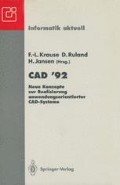Abstract
We present our constraint-based geometric modeling system named FLEXI. Creation of an object begins with a sketch carrying a topological information and approximal values of object’s geometry. Geometrical constraints are then interactively inserted. Benefits of the presented geometric modeling system are un- necessity of giving constraints in correct order and the ability of replacing incorrect constraints with their inverse constraints by the system itself. A new structure - a biconnected constraint description graph enables these benefits. A triggering mecha-nism for controlling of the constraint propagation is developed for this structure. An algorithm for converting the biconnected constraint description graph into an acyclic constraint description graph is briefly explained. Managing of the over-dimensioning is solved by introduction of a priority mechanism.
Zusammenfassung
Wir stellen unseres geometrisches Modelliersystem vor. Es basiert auf den geometrische Beschränkungen. Es ist gennant FLEXI. Die Kreation eines Objektes beginnt mit einem Entwurf, der eine topologische Information und ungefähre Werte von der Geometrie des Objektes enthält. Geometrische Beschränkungen sind dann interaktiv eingesetzt. Der Vorzug des vorgestellten Systems sind die Unnotwendigkeit der Eintragung der Beschränkungen in richtiger Ordnung und die Fähigkeit der Ersatzung der falschen Beschränkungen mit ihren inversen Beschränkungen von dem System alein. Das alles ermöglicht eine neue Strukture — ein bigenbundener Beschränkungenschildener Graph. Für diese Struktur wurde ein neuer Auslösemehanismus für Kontrollierung der Beschränkungenverbreitigung entworfen. Der Algoritmus für Konvertierung eines bigebundenen Beschränkungenschildenen Graphes in einen nicht-zyklischen Beschränkunenschildenen Graph ist auch beschrieben. Mit dem Einsatz des Prioritätsmechanismus ist das Problem der Überdimensionierungen gelöst.
Access this chapter
Tax calculation will be finalised at checkout
Purchases are for personal use only
Preview
Unable to display preview. Download preview PDF.
References
Akman, V., ten Hagen, P. J. W., and Tomiyama, T.: A fundamental and theoretical framework for an intelligent CAD system. Comput. Aided Design 22 (1990) 352–367
Aldefeld, B.: Variation of geometries based on a geometric-reasoning method. Comput. Aided Design 20 (1988) 117–126
Aldefeld, B., Malberg, H., Richter, H., and Voss, K.: Rule-Based Variational Geometry in Computer-Aided Design. In Artificial Intelligence in Design Pham, D. T. (Eds.) Springer-Verlag (1991) 27–46
Ando, H., Suzuki, H., and Kimura, F.: A geometric reasoning system for mechanical product design. In Computer Applications in Production and Engineering Kimura F. and Rolstadas, A. (Eds.) Elsevier Science Publishers (1989) 131–139
Arbab, F. : Examples of Geometric Reasoning in OAR. In Intelligent CAD Systems II Akman, V., ten Hagen, P. J. W., Veerkamp, P. J. (Eds.) Springer Verlag (1989) 32–57
Borning, A.: The programming language aspects of ThingLab, a constraint-oriented simulation laboratory. ACM TOPLAS 3 (1981) 353–387
Dahshan, K. E. and Barthes, J. P.: Implementing Constraint Propagation in Mechanical CAD System. In Intelligent CAD Systems II Akman, V., ten Hagen, P. J. W., Veerkamp, P. J. (Eds.) Springer Verlag (1989) 227–217
Emmerik, M. J. G. M. van : A System for Interactive Graphical Modeling with Three- Dimensional Constraints. In CG International ‘90 Chua, T. S., Kunii, T. L. (Eds.) Springer Verlag (1990) 361–376
Kimura, F., Suzuki, H., and Wingard, L.: A Uniform Approach to dimensioning and tolerancing in product modelling. In Computer Applications in Production and Engineering Estensen, K. B., Falster, P., and Warman, E. A. (Eds.) Elsevier Science Publishers (1987) 165–178
Kondo, K.: PIGMOD: parametric and interactive geometric modeller for mechanical design. Comput. Aided Design 22 (1990) 633–644
Kitzmiller, C. T. and Kowalik, J. S.: Coupling Symbolic and Numeric Computating in Knowledge-Based Systems. AI Magazine 8 No. 3 (1987) 85–90.
Leier, W.: Constraint Programming Language. Addison-Wesley (1988)
Light, R. and Gossard, D. C.: Modification of geometric models through variational geometry. Comput. Aided Design, 14 (1982) 209–214
Lin, V. C., Gossard, D. C., and Light, R. A.: Variational geometry in computer-aided design. Comput. Graphics 15 (1981) 171–177
Manber, U.: Introduction to algorithms: A Creative Approach. Addison-Wesley (1989)
Mäntylä, M.: An Introduction to Solid Modeling. Computer Science Press (1988)
Mortenson, M. E.: Geometric Modeling. John Wiley Sz Sons (1985)
Nelson, G.: Juno, a constraint-based graphics system. Computer Graphics 19 (1985) 235–243
Roller, D., Schonek, F., and Verroust, A.: Dimension-driven Geometry in CAD: A Survey. In Theory and Practice of Geometric Modeling Strasser, W., Seidel, H.-P. (Eds.) Springer Verlag (1989) 509–523
Rossignac, J. R., Borrel, P., and Nackman, L. R.: Interactive Design with Sequences of Parameterized Transformations. In Intelligent CAD Systems II Akman, V., ten Hägen, P. J. W., Veerkamp, P. J. (Eds.) Springer Verlag (1989) 93–125
Shimada, K., Numao, M., Masuda, H., and Kawabe, S.: Constraint-based object description for product modeling. In Computer Applications in Production and Engineering Kimura F. and Rolstadas A. (Eds.) Elsevier Science Publishers (1989) 95–106
Sutherland, I. E. : Sketchpad - A man-machine graphical communication system. Proceedings of the Spring Joint Computer Conference (1963) 329–346
Sunde, G. : CAD System with Declarative Specification of Shape. Eurographics Workshop on Intelligent CAD Systems (1987) 90–104
Suzuki, H., Ando, H., and Kimura, F.: Geometric constraints and reasoning for geometrical CAD systems. Comput. amp; Graphics 14 (1990) 211–224
Wilson, P. R.: Euler formulas and geometric modeling. Comput. Graphics amp;: Applications 5 No. 8 (1985) 24 - 36
Woodbury, R. F.: Variations in solids: A declarative treatment. Comput. amp; Graphics, 14 (1990) 173–188
Author information
Authors and Affiliations
Editor information
Editors and Affiliations
Rights and permissions
Copyright information
© 1992 Springer-Verlag Berlin Heidelberg
About this paper
Cite this paper
Žalik, B., Guid, N., Vesel, A. (1992). Parametric Design Using Constraint Description Graph. In: Krause, FL., Jansen, H., Ruland, D. (eds) CAD ’92. Informatik aktuell. Springer, Berlin, Heidelberg. https://doi.org/10.1007/978-3-642-77531-4_20
Download citation
DOI: https://doi.org/10.1007/978-3-642-77531-4_20
Publisher Name: Springer, Berlin, Heidelberg
Print ISBN: 978-3-540-55494-3
Online ISBN: 978-3-642-77531-4
eBook Packages: Springer Book Archive

